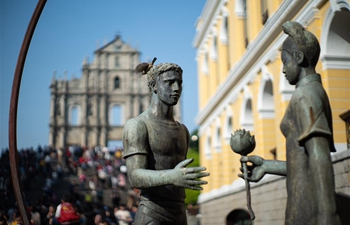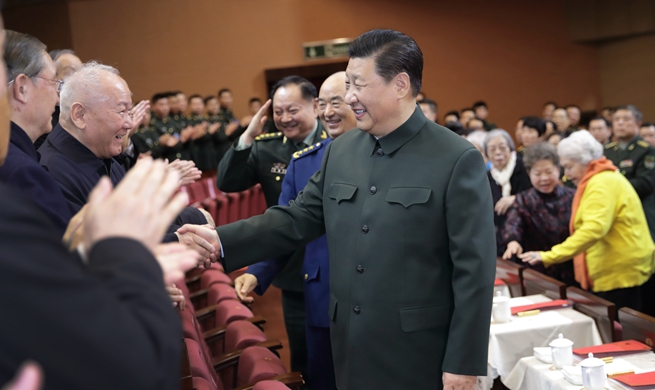BEIJING, Jan. 24 (Xinhua) -- Notebooks featuring skating performances for the royal family and replicas of couplets written by emperors are among the online items the Palace Museum hopes to entice customers to buy this Spring Festival.
Online buyers have snapped up more than 9,000 replicas of the Chinese character "Fu" and couplets written by emperors of the Qing Dynasty (1644-1911) over the past month on the museum's online souvenir shop.
As a Spring Festival tradition, Chinese people put up "Fu" posters, which means good luck and happiness, and couplets on their gates and doors to wish for a good year.
"I purchased notebooks, phone cases and other cultural products with designs inspired by the national treasure on display in the museum as New Year gifts," said Miao Yining, a Beijing-based office worker.
Attracted by the online retail offering, Miao and her family plan to visit the museum and see an exhibition on about the royal Spring Festival.
Museums and galleries have become more commercially minded, realizing cultural merchandise can increase their impact and online shopping can be a way of creating loyalty among a younger generation.
By the end of last year, more than 10 Chinese museums including the National Museum of China, the Summer Palace, and Emperor Qinshihuang's Mausoleum Site Museum have opened shops on Alibaba's Tmall, selling original cultural products ranging from handicrafts and home supplies to stationery.
Even the British Museum opened an online store on Tmall in July last year, aiming to tap the burgeoning Chinese market. The shop was inundated with orders.
In the first 10 months of 2018, the number of searches for "museum" was more than double the figure in the same period of 2016 on Tmall and Taobao, two major e-commerce retail platforms in China.
Four entries can be found on the official website of the Palace Museum, directing users to various stores on different Chinese social media and e-commerce platforms.
The museum has been turned from a historic landmark into a consumer brand, selling various merchandise from Chinese-style paper tapes, table mats and canvas bags to lipsticks and scarves.
According to Yan Hongbin, vice curator of the museum, the sales of the original cultural products on its Tmall store alone have recorded a nearly 200-percent growth every year.
Museums are a key way for Chinese people to learn about the country's cultural relics.
The number of museums in China has increased from 349 in 1978 to currently over 5,000. Around 1 billion trips were made to the museums each year, according to the National Cultural Heritage Administration.
Thanks to people's growing enthusiasm for museums and cultural heritage, TV programs such as "National Treasure," showcasing the history of China's cultural relics, have become a huge hit.
Jin Wei, researcher with culture and economics institute at the Communication University of China, said the museums could better communicate with younger consumers and promote long-neglected culture to the public via e-commerce.
"The collections in the museums are not only for display. Now museums add cultural symbols to the commodities such as bookmarks and T-shirts, allowing the culture to truly integrate into people's daily life," Jin said.
However, he pointed out that only a small portion of museums can stabilize revenue streams by developing and selling cultural products online.
"The cultural and creative industry is complicated. What it tests is the museums' comprehensive strength involving market research, innovative designs and branding," Jin said.
Chen Shaofeng, vice dean of the Institute for Cultural Industries at Peking University, has warned against overcommercialization ss museums and e-commerce platforms deepen their cooperation, saying it could affect the image of museums.

















